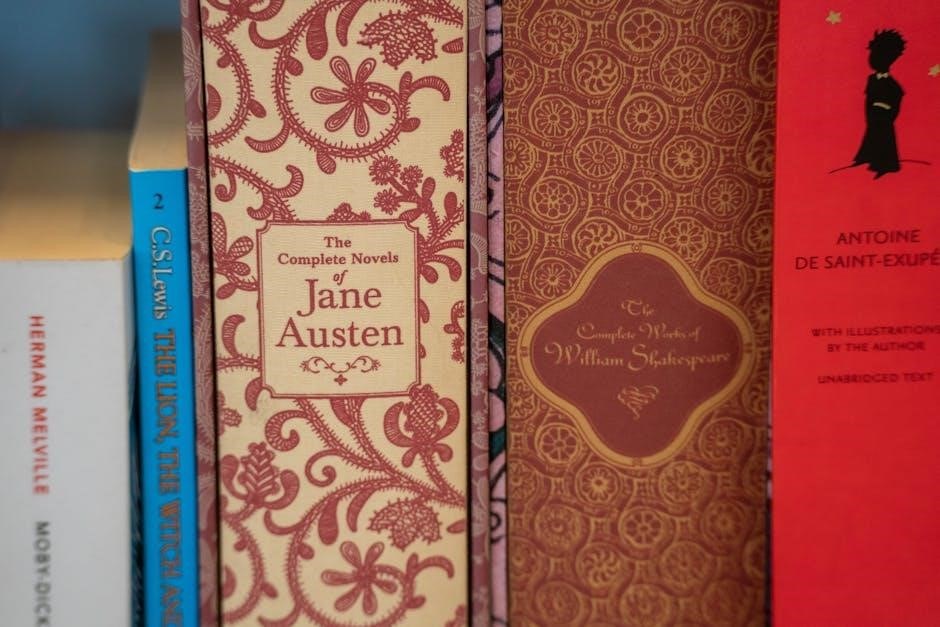Jane Austen’s Emma is a timeless novel exploring themes of love‚ class‚ and self-discovery in 19th-century England‚ renowned for its witty prose and insightful character portrayals.
1.1 Background and Publication History
Written by Jane Austen‚ Emma was first published in December 1816 by John Murray in London. It was Austen’s fourth novel‚ following the success of Pride and Prejudice. The novel was initially published anonymously‚ with the author credited only as “A Lady.” Austen’s identity was revealed in later editions. The title character‚ Emma Woodhouse‚ was conceived by Austen as a heroine “whom no one but myself will much like‚” reflecting her intention to create a flawed yet endearing protagonist. The novel was moderately successful upon release‚ with 1‚200 copies sold in the first two years. Over time‚ Emma gained acclaim for its nuanced portrayal of society and human nature‚ becoming one of Austen’s most celebrated works. Its witty dialogue and psychological depth continue to captivate readers and scholars alike.
1.2 Overview of the Novel’s Themes
Jane Austen’s Emma explores several enduring themes central to its narrative. Social class and status are prominent‚ as the novel critiques the hierarchical society of 19th-century England. Love and marriage are also key‚ with Emma’s misguided attempts at matchmaking highlighting the complexities of relationships. Self-discovery emerges as Emma confronts her flaws and matures‚ learning from her errors. The novel further examines friendship‚ deception‚ and the consequences of misjudgment. Through its intricate characters and situations‚ Emma delves into the human condition‚ offering insights into personal growth and societal norms. These themes‚ intertwined with Austen’s sharp wit and observation‚ create a rich and thought-provoking narrative that remains relevant today.

Plot Summary of Emma
Emma Woodhouse‚ a wealthy and meddling young woman‚ attempts to orchestrate love lives in her village‚ often causing misunderstandings. Her interference leads to complications‚ but ultimately‚ truths unfold‚ and harmony is restored as Emma learns from her mistakes and finds love herself.
2.1 Key Events in the Novel
Emma Woodhouse‚ determined to play matchmaker‚ meddles in the lives of those around her‚ starting with Harriet Smith‚ whom she encourages to reject a marriage proposal from Mr. Martin‚ a farmer‚ in favor of the higher-status Mr. Elton. However‚ Mr. Elton proves to be self-important and rejects Harriet‚ instead pursuing Emma. Meanwhile‚ the arrival of Frank Churchill and Jane Fairfax introduces mystery and tension‚ as their relationship is shrouded in secrecy. At a picnic at Box Hill‚ Emma humiliates Miss Bates‚ revealing her own flaws. Eventually‚ truths unfold: Frank and Jane are secretly engaged‚ and Mr. Knightley‚ Emma’s confidant‚ reveals his love for her. Emma learns from her mistakes‚ and the novel concludes with her marriage to Mr. Knightley and the union of Harriet and Mr. Martin‚ restoring harmony to the community.
2.2 The Climax and Resolution
The climax occurs at Box Hill‚ where Emma’s thoughtless remarks to Miss Bates expose her own immaturity and insensitivity. Mr. Knightley confronts Emma‚ prompting her to reflect on her actions and seek redemption. Meanwhile‚ Frank Churchill’s true relationship with Jane Fairfax is revealed‚ freeing Harriet from her infatuation with him. Emma reconciles with Harriet and makes amends with Miss Bates. The novel resolves with Emma’s marriage to Mr. Knightley‚ symbolizing her growth and acceptance of love based on mutual respect. Harriet marries Mr. Martin‚ and Jane and Frank wed‚ restoring harmony and balance to the community. Through these events‚ Austen masterfully ties up loose ends‚ emphasizing personal growth and the triumph of reason over vanity.

Main Characters in Emma
Emma revolves around Emma Woodhouse‚ a wealthy‚ young matchmaker‚ and Mr. Knightley‚ her wise mentor. Other key characters include Harriet Smith‚ Frank Churchill‚ and Jane Fairfax‚ whose lives intertwine‚ shaping Emma’s journey of self-discovery and growth.
3.1 Emma Woodhouse: Traits and Development
Emma Woodhouse is the novel’s protagonist‚ a wealthy‚ intelligent‚ and determined young woman. However‚ her confidence often leads to arrogance and meddling in others’ lives. Initially‚ her attempts at matchmaking reveal her immaturity and lack of self-awareness. Through her mistakes‚ particularly with Harriet Smith and Jane Fairfax‚ Emma faces criticism from Mr. Knightley‚ prompting her to reflect on her actions. Her development is marked by gradual humility and a deeper understanding of her own emotions. By the novel’s end‚ Emma evolves from a self-centered matchmaker to a more empathetic and responsible individual‚ ready for a mature relationship with Mr. Knightley.
3.2 Mr. Knightley: The Voice of Reason
Mr. Knightley‚ a close friend and neighbor of Emma Woodhouse‚ serves as her moral guide and critic. His wisdom‚ fairness‚ and strong sense of responsibility make him a steady influence in Emma’s life. Unlike Emma‚ Mr. Knightley is grounded in reality‚ often correcting her misconceptions and encouraging self-reflection. His patient yet firm demeanor helps Emma navigate her errors‚ particularly in her meddling with others’ relationships. Over time‚ Emma comes to appreciate his sound judgment and unwavering kindness‚ leading to a deeper understanding of her own feelings for him. Mr. Knightley’s role is pivotal in Emma’s growth‚ as he embodies the voice of reason and integrity in her journey toward maturity and love.
3.3 Other Significant Characters (Frank Churchill‚ Jane Fairfax‚ Harriet Smith)
Frank Churchill‚ though charming‚ hides his secret engagement with Jane Fairfax‚ creating intrigue and tension in the novel. Jane Fairfax‚ reserved and talented‚ struggles with societal expectations and limited opportunities for women. Harriet Smith‚ young and impressionable‚ becomes Emma’s protégée‚ often led astray by Emma’s misguided interference. Each character adds depth to the story‚ highlighting themes of societal pressures‚ hidden emotions‚ and the challenges of relationships. Their interactions with Emma and Mr. Knightley drive the plot‚ showcasing Austen’s ability to craft complex‚ relatable characters. Together‚ they enrich the narrative‚ offering insights into the social dynamics of 19th-century England.

Themes in Emma
Jane Austen’s Emma explores themes of social class‚ love‚ and self-discovery‚ offering a nuanced critique of societal norms while highlighting personal growth and relationships.
4.1 Social Class and Status
In Emma‚ Jane Austen critically examines the social hierarchy of 19th-century England‚ highlighting the rigid class system and its impact on characters’ lives. Emma Woodhouse‚ as a member of the upper class‚ embodies the privileges and responsibilities associated with her status. The novel illustrates how social standing influences opportunities‚ relationships‚ and even marriage prospects. Characters like Mr. Knightley‚ with his moral integrity‚ and the Coles‚ representing the rising middle class‚ showcase the complexities of navigating societal expectations. Austen’s portrayal of class distinctions underscores the limitations placed on individuals‚ particularly women‚ whose roles were often defined by their marital and economic status rather than personal merit. The novel serves as a commentary on the social stratification of Austen’s time.
4.2 Love‚ Marriage‚ and Relationships
Emma explores the complexities of love‚ marriage‚ and relationships in 19th-century England‚ where societal expectations often overshadow personal feelings. Emma Woodhouse‚ though well-intentioned‚ interferes in the lives of those around her‚ leading to misunderstandings and misjudgments. Her own journey from self-delusion to self-awareness highlights the challenges of navigating love and relationships. The novel portrays various types of unions‚ from the manipulative relationship between Frank Churchill and Jane Fairfax to the genuine connection between Harriet Smith and Mr. Martin. Through these narratives‚ Austen critiques the societal pressures that governed marriage‚ particularly for women‚ while emphasizing the importance of mutual respect and understanding in forming lasting relationships.
4.3 Self-Discovery and Personal Growth
Emma’s journey is a profound exploration of self-discovery and personal growth‚ as she evolves from a naive‚ meddling matchmaker to a mature‚ self-aware individual. Initially‚ Emma’s confidence in her judgment often leads her astray‚ as she misinterprets others’ intentions and oversteps boundaries. However‚ through a series of humbling experiences and Mr. Knightley’s gentle yet firm guidance‚ Emma develops a deeper understanding of herself and others. She learns to recognize her flaws‚ such as her tendency to manipulate relationships and her biases rooted in social class. By the novel’s end‚ Emma’s newfound self-awareness allows her to embrace genuine heartfelt connections and personal responsibility‚ showcasing Austen’s nuanced portrayal of growth and transformation.
Literary Devices in Emma
Jane Austen employs irony‚ humor‚ and foreshadowing to craft a narrative rich in social commentary‚ while her use of free indirect speech offers deep character insight.
5.1 Irony and Humor
Jane Austen masterfully uses irony and humor in Emma to critique societal norms and highlight character flaws. The novel’s irony is evident in Emma’s misguided matchmaking attempts‚ often leading to comedic misunderstandings. Austen employs situational irony‚ as Emma’s perceptions of others frequently clash with reality. Her witty dialogue and satirical portrayals of characters like Miss Bates and Mr. Elton add humor‚ while also underscoring the novel’s deeper themes. The interplay between irony and humor not only engages readers but also serves as a commentary on the social class system and the limitations placed on women in 19th-century England. These literary devices make Emma both entertaining and thought-provoking.
5.2 Foreshadowing and Symbolism
Jane Austen skillfully employs foreshadowing and symbolism in Emma to enrich the narrative and hint at future events. For instance‚ the arrival of Jane Fairfax and Frank Churchill early in the novel subtly foreshadows their significant roles in the plot. Symbolism is evident in objects like the pianoforte‚ which represents Jane’s concealed emotions and talents. The gardens at Donwell Abbey symbolize order and harmony‚ contrasting with the chaos caused by Emma’s meddling. Austen’s use of these literary devices adds depth to the story‚ allowing readers to interpret underlying meanings and anticipate developments. Such techniques enhance the novel’s complexity and demonstrate Austen’s mastery of subtle storytelling.

Historical Context of the Novel
Published in 1816‚ Emma reflects early 19th-century England’s societal norms‚ emphasizing social class distinctions and the limited roles of women during the Regency era.
6.1 Life in 19th-Century England
Life in 19th-century England was marked by strict social hierarchies‚ with class distinctions shaping opportunities and interactions. The upper class‚ like Emma Woodhouse‚ enjoyed privilege and leisure‚ while the lower classes faced hardship. Women’s roles were limited‚ with marriage often seen as a means of securing social status and financial stability. The rise of the middle class and industrialization began to shift societal dynamics‚ though traditional norms persisted. Austen’s portrayal of this era critiques the limitations placed on women and highlights the nuances of social maneuvering‚ offering a vivid glimpse into the lives of early 19th-century English society.
6.2 The Role of Women in Society
In 19th-century England‚ women’s roles were heavily dictated by societal norms‚ with marriage often viewed as their primary purpose. Women from wealthy families‚ like Emma Woodhouse‚ enjoyed greater freedom but were still confined by expectations of femininity and domesticity. Education and career opportunities were limited‚ and women were largely excluded from political and economic decision-making. The novel critiques these restrictions‚ highlighting the societal pressures women faced in navigating their roles. Austen’s portrayal of characters like Emma‚ Harriet‚ and Jane Fairfax underscores the challenges of finding personal agency within a system that emphasized marriage and social standing as the ultimate goals for women.

Critical Analysis of Emma
Jane Austen’s Emma has been subject to extensive critical analysis since its publication. While celebrated for its insightful characterizations and societal commentary‚ some critics find fault with its character development.
7.1 Strengths of the Novel
Jane Austen’s Emma is celebrated for its exceptional character development‚ particularly in the titular character‚ Emma Woodhouse‚ whose flaws and growth make her relatable and engaging. The novel’s use of irony and humor is a standout feature‚ offering both entertainment and social commentary. Austen’s exploration of themes like social class‚ love‚ and self-discovery is timeless‚ resonating with readers across generations. The novel’s structure‚ with its well-paced narrative and intricate plot‚ ensures a compelling read. Additionally‚ the moral lessons embedded in Emma’s journey‚ such as the dangers of misjudgment and the importance of self-awareness‚ add depth to the story. These elements solidify Emma as a masterpiece of English literature.
7.2 Weaknesses and Criticisms
Despite its acclaim‚ Emma has faced criticism for its narrow focus on upper-class society‚ which some argue limits its broader appeal. Emma’s meddling and snobbery can make her unlikable‚ frustrating readers. Additionally‚ the novel’s pacing has been criticized as slow‚ particularly in the early chapters‚ and its limited narrative perspective‚ centered on Emma‚ restricts deeper exploration of secondary characters. These elements‚ while not diminishing the novel’s literary merit‚ highlight areas where modern readers may find it less accessible or engaging compared to more diverse or fast-paced narratives.

Adaptations and Interpretations
Emma has inspired numerous adaptations‚ including films‚ TV series‚ and modern retellings‚ showcasing its timeless appeal and versatility across different mediums and cultural contexts.
8.1 Film and Television Adaptations
Jane Austen’s Emma has been adapted into numerous films and television series‚ each offering unique interpretations of the novel. The 1996 film starring Gwyneth Paltrow as Emma Woodhouse is particularly celebrated for its faithfulness to the source material. Similarly‚ the 1996 ITV adaptation‚ featuring Kate Beckinsale‚ captures the wit and charm of Austen’s prose. In 2009‚ a four-part mini-series aired on BBC One‚ starring Romola Garai‚ which received acclaim for its detailed portrayal of the characters and settings. More recently‚ the 2020 film adaptation‚ directed by Autumn de Wilde and starring Anya Taylor-Joy‚ brought a fresh‚ visually stunning take to the story‚ appealing to both classic and modern audiences. These adaptations highlight the enduring appeal of Austen’s work across generations and mediums.
8.2 Modern Retellings and Inspired Works
Modern retellings of Emma have creatively reimagined Austen’s timeless story for contemporary audiences. Works like Eligible by Curtis Sittenfeld and Emma: A Modern Retelling by Alexander McCall Smith offer fresh perspectives‚ blending the novel’s themes with modern settings. The 1995 film Clueless‚ set in Beverly Hills‚ reinterpreted Emma as a wealthy‚ fashion-forward high school student‚ showcasing the adaptability of Austen’s characters; Inspired works‚ such as web series and graphic novels‚ further explore Emma’s journey of self-discovery and matchmaking misadventures. These reinterpretations highlight the universal appeal of Austen’s exploration of social dynamics‚ love‚ and personal growth‚ ensuring her legacy endures across generations and cultural contexts.
The Significance of Emma Today
Jane Austen’s Emma remains a significant work today due to its timeless themes of self-discovery‚ social class‚ and love‚ offering universal appeal and cultural relevance in modern times.
9.1 Timeless Themes and Universal Appeal
Emma endures due to its exploration of universal themes like social class‚ love‚ and self-discovery‚ resonating across generations. Austen’s witty insight into human nature remains relatable‚ offering timeless lessons on personal growth‚ misunderstandings‚ and the complexities of relationships. The novel’s humor and irony‚ coupled with its nuanced characterization‚ continue to captivate readers‚ bridging the gap between 19th-century England and modern society. Its exploration of societal pressures‚ individual aspirations‚ and the pursuit of happiness ensures its relevance today‚ making it a cherished classic in world literature.
9.2 Cultural and Literary Impact
Emma has left an indelible mark on literature and culture‚ influencing countless adaptations. Its nuanced portrayal of society and human behavior continues to resonate. The novel’s strong female characters and critique of social hierarchies have made it a cornerstone of feminist literature. Additionally‚ its exploration of personal growth and relationships has inspired modern retellings in film‚ television‚ and literature. Austen’s witty dialogue and insightful character development raised the bar for literary craftsmanship. Emma’s enduring popularity highlights its ability to transcend time‚ offering timeless lessons on love‚ class‚ and self-awareness. Its cultural and literary impact remains unparalleled‚ solidifying its place as a cherished classic.
Jane Austen’s Emma remains a timeless masterpiece‚ offering profound insights into human nature and society. Its enduring appeal lies in its relatable themes and masterful storytelling.
10.1 Recap of Key Points
Emma Woodhouse‚ a wealthy and somewhat spoiled young woman‚ navigates matchmaking‚ misunderstandings‚ and personal growth in 19th-century England. Through her flawed yet well-meaning attempts to arrange marriages‚ Austen explores themes of social class‚ love‚ and self-discovery. Mr. Knightley serves as a moral guide‚ challenging Emma to recognize her errors and mature. The novel’s intricate plot‚ filled with irony and humor‚ examines societal norms and the complexities of relationships. Austen’s sharp observations of human nature and her masterful use of dialogue make Emma a timeless classic‚ offering insights into both the past and present‚ ensuring its enduring relevance and appeal.
10.2 Final Thoughts on Emma’s Enduring Legacy
Jane Austen’s Emma remains a timeless masterpiece‚ celebrated for its universal themes of love‚ class‚ and self-discovery. Its legacy endures through its relatable exploration of human nature‚ enhanced by Austen’s sharp wit and insightful character development. The novel’s ability to adapt across generations‚ seen in numerous adaptations and modern reinterpretations‚ underscores its lasting appeal. Emma’s journey from self-deception to self-awareness continues to captivate readers‚ offering timeless lessons on personal growth and societal norms. As a literary icon‚ Emma not only reflects its era but also continues to resonate with contemporary audiences‚ solidifying its place as a cornerstone of English literature.